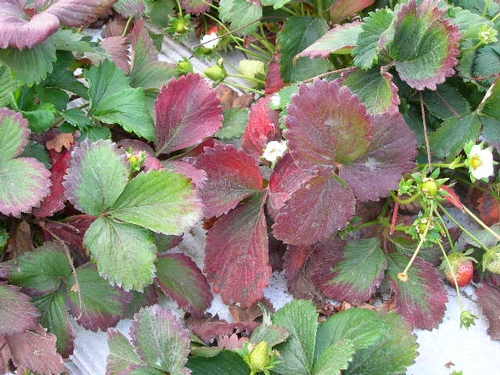Posts Tagged: nutrient
Modifying the Nutritional Guidelines for Nitrogen for the Strawberry Variety ‘Monterey'
The question has come up more than a few times from industry participants on how to adjust nitrogen (N) inputs for strawberry varieties more productive and of larger plant size than Albion for which the original DRIS study was done.
Simple math says one could just increase simply N uptake estimate to cover the added fruit and bigger plant, so if Monterey produces 20% more fruit, and is that much larger a plant, one just adds 20% more nitrogen to the standard annual fertility program to make up the difference. However, as simple as this math may seem, it could quite possibly be incorrect, since it is not at all unknown that different strawberry varieties have variations in N content in the fruit and leaves.
The work to determine N content of Monterey compared to that of Albion was done over two samplings (one in early May, the other mid-July) of five fields of Albion and five fields of Monterey. We found that Monterey had marginally higher N concentrations in both the leaves (Table 1) and the fruit (Table 2) on both sample dates. An evaluation of plant size, without fruit, found that Monterey also ran about 20% larger than Albion from the five fields sampled.
From this information, we can say that N uptake is at least as high in Monterey as in Albion per unit of plant growth. That is to say, if a grower expects and has experienced 20-25% increases in fruit yield with Monterey over that of Albion, then the amount of N uptake to support that level of productivity will also be 20-25% higher than for Albion.
We need to be careful here however. This is not a call for growers of Monterey to automatically increase their N fertilizer additions by 25%. If a grower is finding his or her seasonal practices in the lower half of typical grower practice, then an increase in nitrogen application could be tested, but if a grower is already using a lot of N, say above 250 lbs per acre, then that might be enough to absorb the higher N requirement of Monterey.
Table 1: Nitrogen (N) concentrations in dry leaves
|
Variety |
4-5 May |
12-15 July |
|
Monterey |
3.02 % |
2.71 % |
|
Albion |
2.81 % |
2.44 % |
Table 2: Nitrogen (N) concentrations in dried fruit
|
Variety |
4-5 May |
12-15 July |
|
Monterey |
1.28 % |
1.06 % |
|
Albion |
1.22 % |
0.93 % |
Many thanks to the growers who participated in this study, and generously allowed me to tear plants out of their fields for the plant size sampling.
A Primer on Nutrient Deficiency Symptoms and How to Address Them
Here is a really nice article from Robert Mikkelson with the International Plant Nutrition Institute (IPNI), great website overall actually.
The link below goes to the full article, but I'll capture a few highlights in a summary:
Plant nutrient deficiency symptoms appear when a nutrient is lacking, but this can have multiple causes. It can be because root activity is low because of soil saturation and low temperatures, or it can be poor uptake from disease or mechanically damaged roots. And of course low nutrient supplying power on the part of the soil can be part of the equation as well. The field practitioner needs to get the full picture.
Deficient plants do not initially show any signs of nutrient shortage other than growing slower and having an more uneven, lower yield. At the point that deficiency symptoms become visible, the crop is already severely stressed and although it's already quite late to do so, steps must be taken to correct the deficiency. This is an important point, and definitely part of the reason I constantly push for growers and agricultural professionals to be taking tissue samples at several points through the season to catch deficiencies and problems before they deal irreversible damage to the crop.
Speaking of those tissue samples, take tissue samples from healthy areas at the same time you take samples from the deficient areas (I take two of each at a minimum). That way you can compare the two areas and more easily identify what is deficient. It's also useful to take soil samples from those same healthy and deficient areas at the same time of tissue samples in order to get a fuller view of what is going on.
Here's the link, Dr. Mikkelson does a way better job of explaining this than I do:

Severely purpled leaves on Albion. What's the deal here?

